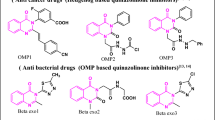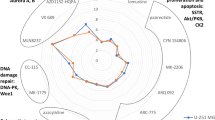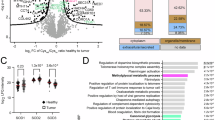Abstract
Aim:
Glyoxalase I (GLOI), a glutathione (GSH)-dependent enzyme, is overexpressed in tumor cells and related to multi-drug resistance in chemotherapy, making GLOI inhibitors as potential anti-tumor agents. But the most studied GSH analogs exhibit poor pharmacokinetic properties. The aim of this study was to discover novel non-GSH analog GLOI inhibitors and analyze their binding mechanisms.
Methods:
Mouse GLOI (mGLOI) was expressed in BL21 (DE3) pLysS after induction with isopropyl-β-D-1-thiogalactopyranoside and purified using AKTA FPLC system. An in vitro mGLOI enzyme assay was used to screen a small pool of compounds containing carboxyl groups. Crystal structure of the mGLOI-inhibitor complex was determined at 2.3 Å resolution. Molecular docking study was performed using Discovery Studio 2.5 software package.
Results:
A natural compound 18-β-glycyrrhetinic acid (GA) and its derivative carbenoxolone were identified as potent competitive non-GSH analog mGLOI inhibitors with Ki values of 0.29 μmol/L and 0.93 μmol/L, respectively. Four pentacyclic triterpenes (ursolic acid, oleanolic acid, betulic acid and tripterine) showed weak activities (mGLOI inhibition ratio <25% at 10 μmol/L) and other three (maslinic acid, corosolic acid and madecassic acid) were inactive. The crystal structure of the mGLOI-GA complex showed that the carboxyl group of GA mimicked the γ-glutamyl residue of GSH by hydrogen bonding to the glutamyl sites (residues Arg38B, Asn104B and Arg123A) in the GSH binding site of mGLOI. The extensive van der Waals interactions between GA and the surrounding residues also contributed greatly to the binding of GA and mGLOI.
Conclusion:
This work demonstrates a carboxyl group to be an important functional feature of non-GSH analog GLOI inhibitors.
Similar content being viewed by others
Log in or create a free account to read this content
Gain free access to this article, as well as selected content from this journal and more on nature.com
or
References
Thornalley PJ . Glyoxalase I--structure, function and a critical role in the enzymatic defence against glycation. Biochem Soc Trans 2003; 31: 1343–8.
Sousa Silva M, Gomes RA, Ferreira AE, Ponces Freire A, Cordeiro C . The glyoxalase pathway: The first hundred years and beyond. Biochem J 2013; 453: 1–15.
Cameron AD, Ridderström M, Olin B, Kavarana MJ, Creighton DJ, Mannervik B . Reaction mechanism of glyoxalase I explored by an X-ray crystallographic analysis of the human enzyme in complex with a transition state analogue. Biochemistry 1999; 38: 13480–90.
Kalsi A, Kavarana MJ, Lu T, Whalen DL, Hamilton DS, Creighton DJ . Role of hydrophobic interactions in binding S-(N-aryl/alkyl-N-hydroxycarbamoyl)glutathiones to the active site of the antitumor target enzyme glyoxalase I. J Med Chem 2000; 43: 3981–6.
Thornalley PJ, Rabbani N . Glyoxalase in tumourigenesis and multidrug resistance. Semin Cell Dev Biol 2011; 22: 318–25.
Creighton DJ, Zheng ZB, Holewinski R, Hamilton DS, Eiseman JL . Glyoxalase I inhibitors in cancer chemotherapy. Biochem Soc Trans 2003; 31: 1378–82.
Sousa Silva M, Ferreira AE, Gomes R, Tomás AM, Ponces Freire A, Cordeiro C . The glyoxalase pathway in protozoan parasites. Int J Med Microbiol 2012; 302: 225–9.
Suttisansanee U, Honek JF . Bacterial glyoxalase enzymes. Semin Cell Dev Biol 2011; 22: 285–92.
Vince R, Brownell J, Akella LB . Synthesis and activity of γ-(L-γ-azaglutamyl)-S-(p-bromobenzyl)-L-cysteinylglycine: a metabolically stable inhibitor of glyoxalase I. Bioorg Med Chem Lett 1999; 9: 853–6.
Takasawa R, Takahashi S, Saeki K, Sunaga S, Yoshimori A, Tanuma S . Structure-activity relationship of human GLO I inhibitory natural flavonoids and their growth inhibitory effects. Bioorg Med Chem 2008; 16: 3969–75.
Zhou Y, Guo T, Li X, Dong Y, Galatsis P, Johnson DS, et al. Discovery of selective 2,4-diaminopyrimidine-based photoaffinity probes for glyoxalase I. MedChemComm 2014; 5: 352–7.
Burg D, Mulder GJ . Glutathione conjugates and their synthetic derivatives as inhibitors of glutathione-dependent enzymes involved in cancer and drug resistance. Drug Metab Rev 2002; 34: 821–63.
Ramana KV, Bhatnagar A, Srivastava S, Yadav UC, Awasthi S, Awasthi YC, et al. Mitogenic responses of vascular smooth muscle cells to lipid peroxidation-derived aldehyde 4-hydroxy-trans-2-nonenal (HNE): role of aldose reductase-catalyzed reduction of the HNE-glutathione conjugates in regulating cell growth. J Biol Chem 2006; 281: 17652–60.
Singh R, White MA, Ramana KV, Petrash JM, Watowich SJ, Bhatnagar A, et al. Structure of a glutathione conjugate bound to the active site of aldose reductase. Proteins 2006; 64: 101–10.
Kawatani M, Okumura H, Honda K, Kanoh N, Muroi M, Dohmae N, et al. The identification of an osteoclastogenesis inhibitor through the inhibition of glyoxalase I. Proc Natl Acad Sci U S A 2008; 105: 11691–6.
Chiba T, Ohwada J, Sakamoto H, Kobayashi T, Fukami TA, Irie M, et al. Design and evaluation of azaindole-substituted N-hydroxypyridones as glyoxalase I inhibitors. Bioorg Med Chem Lett 2012; 22: 7486–9.
Santel T, Pflug G, Hemdan NY, Schäfer A, Hollenbach M, Buchold M, et al. Curcumin inhibits glyoxalase 1— a possible link to its anti-inflammatory and anti-tumor activity. PLoS One 2008; 3: e3508.
Liu M, Yuan M, Luo M, Bu X, Luo HB, Hu X . Binding of curcumin with glyoxalase I: molecular docking, molecular dynamics simulations, and kinetics analysis. Biophys Chem 2010; 147: 28–34.
Liu M, Yuan M, Li Z, Cheng YK, Luo HB, Hu X . Structural investigation into the inhibitory mechanisms of indomethacin and its analogues towards human glyoxalase I. Bioorg Med Chem Lett 2011; 21: 4243–7.
Clutterbuck AL, Asplin KE, Harris P, Allaway D, Mobasheri A . Targeting matrix metalloproteinases in inflammatory conditions. Curr Drug Targets 2009; 10: 1245–54.
Jacobsen FE, Lewis JA, Cohen SM . The design of inhibitors for medicinally relevant metalloproteins. ChemMedChem 2007; 2: 152–71.
Zhai J, Zhang H, Zhang L, Zhao Y, Chen S, Chen Y, et al. Zopolrestat as a human glyoxalase I inhibitor and its structural basis. ChemMedChem 2013; 8: 1462–4.
Kawatani M, Okumura H, Honda K, Kanoh N, Muroi M, Dohmae N, et al. The identification of an osteoclastogenesis inhibitor through the inhibition of glyoxalase I. Proc Natl Acad Sci U S A 2008; 105: 11691–6.
Collaborative Computational Project, Number 4. The CCP4 suite: programs for protein crystallography. Acta Crystallogr D Biol Crystallogr 1994; 50: 760–3.
Adams PD, Afonine PV, Bunkóczi G, Chen VB, Davis IW, Echols N, et al. PHENIX: a comprehensive Python-based system for macromolecular structure solution. Acta Crystallogr D Biol Crystallogr 2010; 66: 213–21.
Emsley P, Cowtan K . Coot: model-building tools for molecular graphics. Acta Crystallogr D Biol Crystallogr 2004; 60: 2126–32.
Iio M, Ishimoto S, Nishida Y, Shiramizu T, Yunoki H . Effects of baicalein, a flavonoid, and other anti-inflammatory agents on glyoxalase-i activity. Agric Biol Chem 1986; 50: 1073.
Vince R, Daluge S, Wadd WB . Inhibition of glyoxalase I by S-substituted glutathiones. J Med Chem 1971; 14: 402–4.
Vander Jagt DL, Hunsaker LA . Methylglyoxal metabolism and diabetic complications: roles of aldose reductase, glyoxalase-I, betaine aldehyde dehydrogenase and 2-oxoaldehyde dehydrogenase. Chem Biol Interact 2003; 143–144: 341–51.
Steuber H, Czodrowski P, Sotriffer CA, Klebe G . Tracing changes in protonation: a prerequisite to factorize thermodynamic data of inhibitor binding to aldose reductase. J Mol Biol 2007; 373: 1305–20.
Hamada Y, Nakamura J . Clinical potential of aldose reductase inhibitors in diabetic neuropathy. Treat Endocrinol 2004; 3: 245–55.
Chung SS, Chung SK . Aldose reductase in diabetic microvascular complications. Curr Drug Targets 2005; 6: 475–86.
Obrosova IG, Kador PF . Aldose reductase/polyol inhibitors for diabetic retinopathy. Curr Pharm Biotechnol 2011; 12: 373–85.
Sharma YR, Cotlier E . Inhibition of lens and cataract aldose reductase by protein-bound anti-rheumatic drugs: salicylate, indomethacin, oxyphenbutazone, sulindac. Exp Eye Res 1982; 35: 21–7.
Wilson DK, Tarle I, Petrash JM, Quiocho FA . Refined 1.8 Å structure of human aldose reductase complexed with the potent inhibitor zopolrestat. Proc Natl Acad Sci U S A 1993; 90: 9847–51.
Lee YS, Kim SH, Jung SH, Kim JK, Pan CH, Lim SS . Aldose reductase inhibitory compounds from Glycyrrhiza uralensis. Biol Pharm Bull 2010; 33: 917–21.
Takemura M, Endo S, Matsunaga T, Soda M, Zhao HT, El-Kabbani O, et al. Selective Inhibition of the tumor marker Aldo-keto reductase family member 1B10 by oleanolic acid. J Nat Prod 2011; 74: 1201–6.
Acknowledgements
The authors thank Dr Hideo OKUMURA (Advanced Science Institute, RIKEN, Japan) for his kindly gift of the mouse GLOI plasmid. The authors gratefully thank the Innovative R&D Team Leadership of Guangdong Province, China (grant No 2011Y038).
Author information
Authors and Affiliations
Corresponding authors
Additional information
Supplementary information is available at Acta Pharmacologica Sinica's website.
Supplementary information
Supplementary Information
Supplementary infomration, Figures, Tables and Data (DOC 1372 kb)
Rights and permissions
About this article
Cite this article
Zhang, H., Huang, Q., Zhai, J. et al. Structural basis for 18-β-glycyrrhetinic acid as a novel non-GSH analog glyoxalase I inhibitor. Acta Pharmacol Sin 36, 1145–1150 (2015). https://doi.org/10.1038/aps.2015.59
Received:
Accepted:
Published:
Issue date:
DOI: https://doi.org/10.1038/aps.2015.59
Keywords
This article is cited by
-
New cytotoxic dammarane type saponins from Ziziphus spina-christi
Scientific Reports (2023)



